Traditionally for industry leaders, the Swiss Jura annually expands the line up of its coffee machines. This year was no exception, and in the spring the company introduced the new flagship Z10.
This model features several significant innovations, including a new brewing unit with Cold Extraction Process, the milk and milk foam temperature setting, an electronically controlled grinder, and much more. Of course, the model aroused the natural interest of consumers and experts.
Today the company only sells the Z10 in Europe. But by the end of this fall, it will be available in America. Jura uses several vendor codes for different regions, including:
– EA – for Europe;
– SA – for Switzerland;
– INTA – for UK, Australia and some other regions.
Jura Z10 Design
Of course, the design of the Z10 is premium. Its style is similar to the elegant compact Jura ENA 8.
The company offers Aluminum White with an aluminum front and Signature Line (Aluminum Dark Inox) with anodized aluminum front and top. White color is in perfect harmony with any interior.
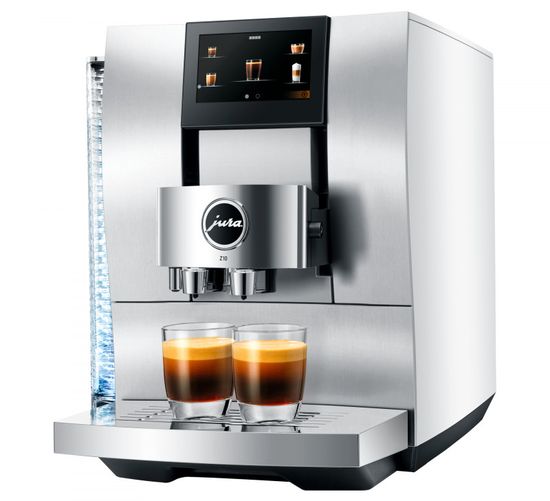
The Z10 Signature Line has a very stylish look.
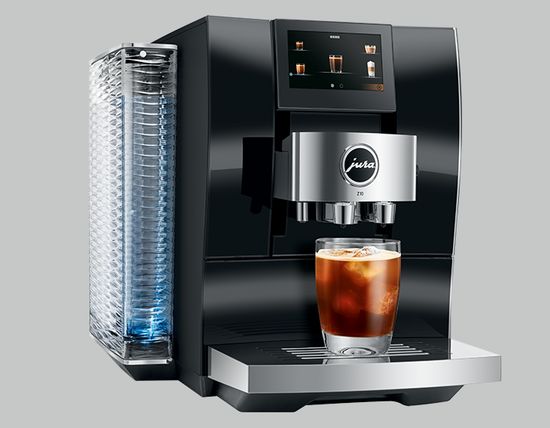
In addition to Aluminum White and Aluminum Dark Inox, the range includes Jura Z10 Aluminum Black, full-body glass front models, Z10 Diamond white and black models. All models differ in color, but have identical functionality.
Stylish bean hopper lid with silicone seal to preserve coffee aroma, and chrome-plated ventilation ‘gills’ are located on the upper surface.
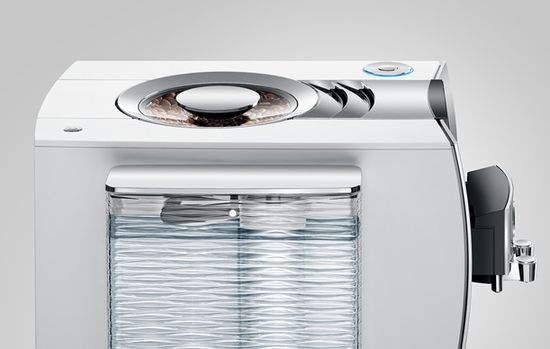
The transparent water tank on the right side is very convenient for visual control of its level.
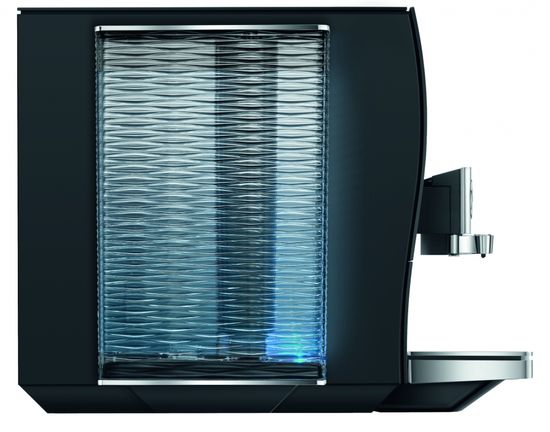
The two-color illumination of the cups and the blue illumination of the water tank add charm to the coffee machine.
Traditionally for Jura, the coffee machine runs very quietly and quickly. Even during grinding, its maximum noise does not exceed 65 dB, which corresponds to the volume of a conversation at a distance of 1 m. The readiness of the drink after the start does not exceed 1 minute. Traditionally for modern premium models, the Z10 has an adjustable coffee dispenser. The adjustment range is 22 – 48 mm in width and 80 – 152 mm in height.
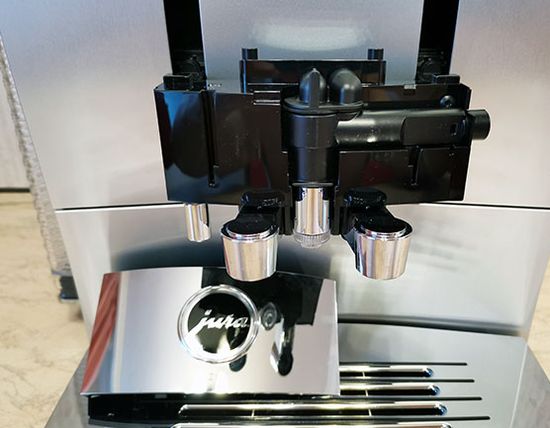
Of course, the coffee machine uses sensors for bean and drip tray filling.
Jura Cold Extraction Process
Usually coffee preparation Cold Brew takes a few hours. This innovative technology makes ice-free 240 ml Cold Brew coffee in 2.5 minutes!
In this mode, the 15 bar Sysko pump pumps cold water directly into the brewing unit without using a thermoblock.
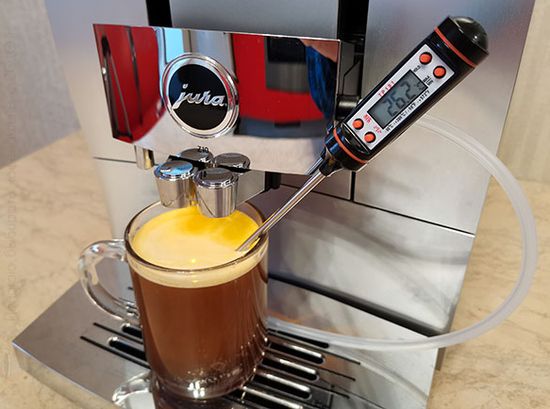
For the Z10, the company has developed a special modification of the brewing unit based on the unique 3D brewing technology (‘eighth generation’).
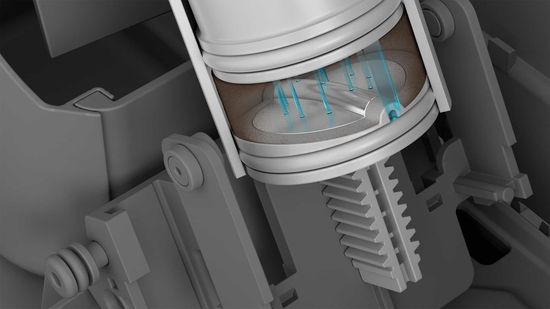
Its lower piston has a volumetric surface and a system for injecting water into a coffee tablet. This nifty engineering solution increases the contact area between the water and the coffee pill. In this case the water contacts the tablet not in one plane, but in 3D space. Under high pressure, the ‘3D’ water shower almost instantly permeates the entire tablet volume, ensuring efficient coffee extraction even with the help of cold water.
This mode is activated within the program or through the upper special menu for most basic drinks, including espresso, coffee and all milk drinks.
Cold Brew key features
But activating this mode is not optimal through the ‘snowflake’ shortcut in the top special menu. The classic Cold Brew requires the coarsest grind, but the machine uses the last setting for the ‘hot’ recipe. Creating a new individual recipe allows the user to set the coarsest grind through the expert mode.
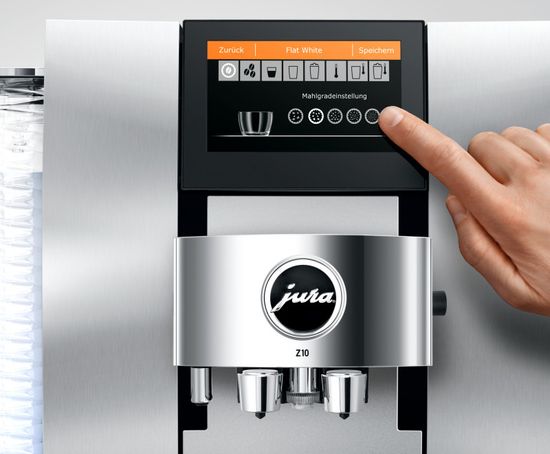
Then the snowflake ‘constant selection’ is turned on and a name is given. After that, the recipe with the required grind can be started in one click from the screen.
The shortcut of gear with grain at the bottom right is a submenu to adjust the grind and strength before cooking one time. These settings are not saved.
Of course, the taste of cold espresso is very specific and not all coffee lovers will like it. But it really is very rich and radically different from coffee after cooling in the refrigerator or with the addition of ice, which is often used in various cold coffee cocktails.
Unfortunately, this mode is not ideal for drinks with milk, which is heated and frothy with hot steam. Even with a minimum temperature of about 52˚C, the temperature of cold coffee-milk drinks ranges from 42-45˚C. But in principle, its taste is very similar to the classic Cold Brew.
Milk and milk foam temperature setting
As known, this feature was implemented in the Z6 and Z8. The Z10 expands on this list. The setting accuracy for any milk recipe reaches 1 second (1 second corresponds to approximately 8-10 ml in cup). These settings are memorized separately for milk and milk froth volume. In principle, the flagships Saeco and Delonghi also support this option, but the Jura Z10 allows the user to additionally adjust and remember the temperature of milk and milk foam.
This advantage is significant enough. Different types of cappuccino makers from different brands froth milk depending on its consistency and with different end temperatures. For example, according to many consumers, Philips LatteGo jugs overheat milk. Of course, the user can cool it down, but after a few minutes it begins to delaminate. On the other hand, many people love hot milk froth in coffee. They complain about the temperature being too low when using the Melitta, Nivona and Jura cappuccino makers.
The Z10 radically solves this problem by allowing the user to select the optimum temperature. The setting range is 10˚C for milk and milk froth. The minimum temperature is 52˚C and the maximum temperature is 65˚C.

As known, the temperature for a classic cappuccino (Flat White program) ranges from 54˚C to 64˚C.
Jura Product Recognizing Grinder (P.R.G.)
Of course, the grinder is one of the essential components of any coffee machine. The Z10 uses an innovative electronic control grinder. Similar to the Delonghi flagship, the Z10 uses uses an additional motor to adjust the gap between the millstones.
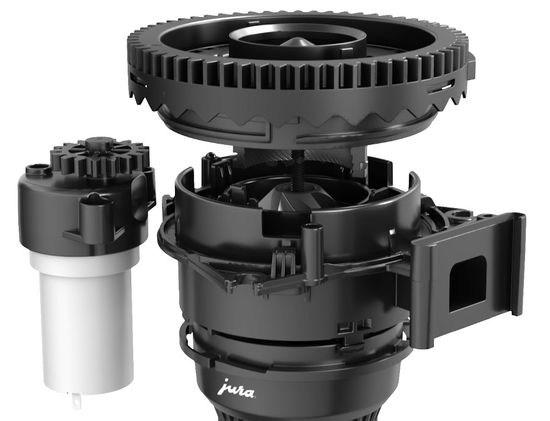
Z10 offers five levels, selectable via the display. Delonghi Maestosa also offers a similar function, but it sets the same grind setting for all drinks and with a long actual delay up to 3-4 cycles. The Z10 proposes this setting for every drink and implements it already in the next cycle. For example, the user can set the second level for espresso and the fifth for Long Cold Brew. By clicking on the shortcut of the corresponding drink, the coffee grinder instantly sets the required degree.
Even great Baratza Sette 270 leaves up to 1 gram of coffee between the millstones from the previous grind. But Z10 brewing unit holds up to 16 grams. In fact, 1 gram corresponds to 6-7%. Therefore, the coffee blend contains more than 90% coffee of the given grind already in the next cup of coffee.
In fact, this system offers a brilliant opportunity for experimentation. The user can make five identical drinks with different grindings and choose the one that suits him best.
Probably, such variability and, most importantly, the instant reaction of the coffee machine to the settings will be able to impress many coffee lovers.
Grind settings can be memorized in a recipe or changed once with a separate menu with a gear and a grain in the lower right corner. In this case, the user selects the desired drink icon, opening a menu with strength and grind. But it’s relevant only for one cycle.
Z10 programs
– Espresso – default 45 ml / setting range 15-80 ml / using P.E.P. technology.
As known, Pulse Extraction Process (P.E.P.) was developed by JURA to optimize the extraction time and increase the coffee saturation. In this mode, the coffee machine forces the hot water through the ground coffee at short intervals.
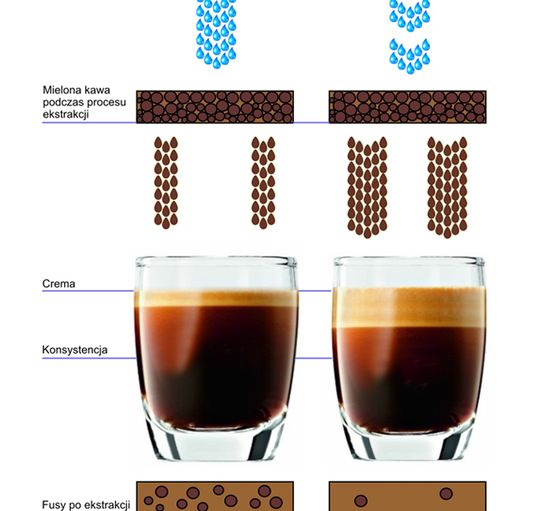
– Coffee (Lungo) – 100 ml / 25-240 ml / without P.E.P.;
– Barista (‘Americano’ – coffee + water) – 60 ml espresso + 40 ml hot water / 25-240 ml coffee + 0-240 ml water / without P.E.P.;
– Lungo Barista – 120 ml coffee + 100ml water / 25-240 ml coffee + 0-240 ml water / without P.E.P.;
– Cappuccino (milk foam + coffee) – 12 seconds milk foam + 60 ml coffee / foam up to 45 seconds (about 400 ml) + coffee 25 – 240 ml / without P.E.P.;
– Latte Macchiato (adjustable pause between milk froth and coffee + separate setting for milk and froth) – 4 seconds milk + 22 seconds froth + 20 seconds pause + 45 ml coffee / milk and milk froth up to 45 seconds each (up to 800 -900 ml) + 0 – 60 sec pause + 25 – 240 ml coffee / without P.E.P.;
– Macchiato (some milk froth + espresso) – the amount of milk and froth can be adjusted separately / with P.E.P;
– Cortado (espresso with P.E.P. + little milk froth, in fact, inverse macchiato) – 25 ml ristretto + 2 sec milk + 1 sec froth;
– Flat White (coffee + milk + little milk foam) – 60 ml coffee + 14 seconds milk + 2 seconds milk foam (about 180-200 ml) / 25-240 ml coffee + 0-45 seconds milk and milk foam / without P.E.P.
Other programs
– Coffee with milk (analogue of Flat White with other presets) – 90 ml coffee + 7 sec milk + 3 sec froth / 25-240 ml coffee + 0-45 sec for milk and milk froth / without P.E.P.
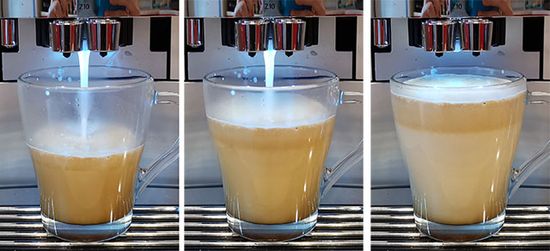
– Milk – 22 sec / 1-45 sec;
– Milk foam – 22 sec. / 1-45 sec;
– Doppio (double espresso) – settings are similar to espresso;
– Coffee pot (1 – 5 cycles of Barista coffee preparation with separate settings for coffee and water) – 3 cycles of 70 ml coffee + 50 ml of water / max 5 cycles of 240 ml of coffee and 240 ml of water = 2400 ml;
– Hot water – 220 ml / 25-300 ml;
– Water for green tea (low temperature) – 220 ml / 25-300 ml.
Unfortunately, the display has only two desktops for 10 recipes. But the user can add desktops and transfer the desired drinks to them. Thus, the maximum number of programs that can be started from the screen is 4 x 5 = 20 drinks.
Unfortunately, the coffee machine does not support user profiles. Of course, this is not a problem for a single person, but not very convenient for a family with several coffee lovers.
The screen sensor has a high sensitivity. But a large number of shortcuts occupy almost the entire active creen area and significantly complicates left / right swipes. At the same time, even a light touch of the shortcut can activate the launch of the corresponding program. Of course, the user gets used to this feature quickly enough, but it looks strange in the premium model. Maybe increasing the screen size or decreasing the number of shortcuts in the future will solve this problem.
Display and J.O.E. app for iOS / Android
The double-speed 4.3” touch display launches up to 20 drinks via the Specialty Selection menu.
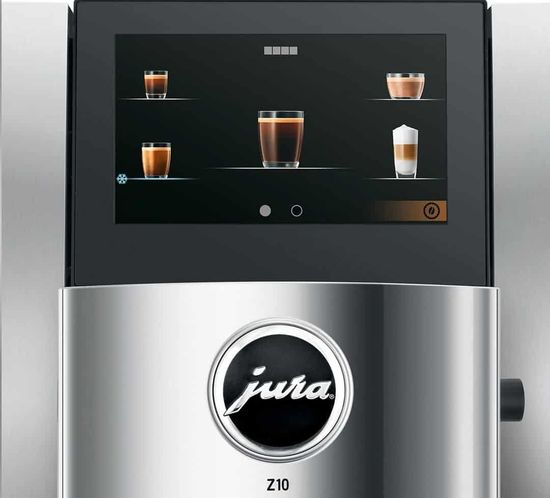
The Blue Crystal Rotary Switch with a button in the middle and blue illumination is used to enter the menu (button in the middle) and select some drinks that are not in the submenu.
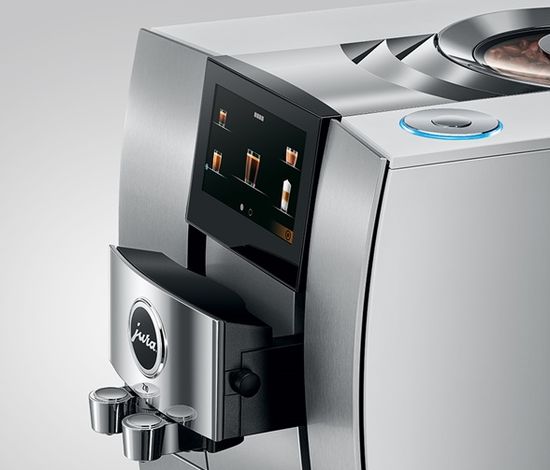
The number of shortcuts in the customizable interface ranges from 2 to 5 drinks. In addition, the top-center display shows four shortcuts, including Cold Drink, Extra shot (milk drink on a double espresso), two black coffees and preparation with ground beans.
In total, the model offers 16 drinks excluding cold recipes, double servings, and Extra Shot based on double espresso. In the latter case, the coffee machine automatically breaks the black coffee component into two successive grindings and makes a drink with coffee dominance in coffee milk drinks.
Probably the Z10 was the first coffee machine to open up all the pros of remote control via the phone. It really helps the user to create and run personalized recipes that are displayed only on the phone. In fact, J.O.E. app acts as a user profile, providing access to all settings for all drinks. Moreover, these recipes do not affect the default settings and recipes created on the coffee machine’s desktops. Accordingly, any changes to app will not destroy them.
Jura Z10 comes with a Wi-Fi Smart Connect adapter that works with a Wi-Fi network in the 2.4 GHz frequency range (5 GHz networks are not supported).
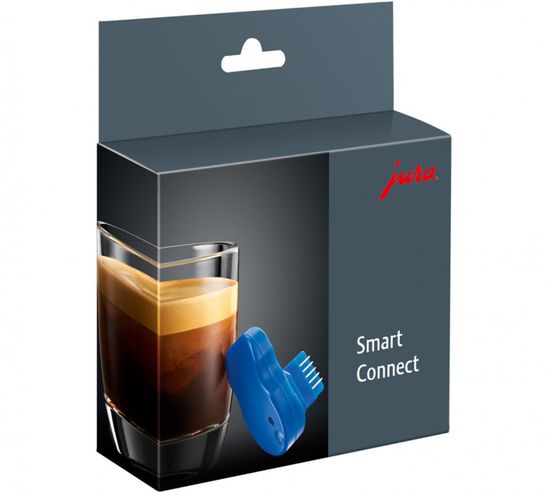
This feature does not require registration in the app, which is a huge plus.
The coffee machine can work with several phones, ensuring shared use, for example, in an office.
Jura Z10 care
Of course, any expensive household appliances require care. But companies traditionally try to simplify it with automation.
Since last year, all Jura models with an automatic cappuccino maker have an automatic rinsing function. The Z10 starts this mode 8 minutes after the last milk drink has been made. In fact, device passes hot water and some steam through the cappuccino maker. Unfortunately, traditionally for all Jura models, the milk hose is not automatically cleaned.
The company argues this aspect for two reasons. Firstly, the instruction recommends cleaning it daily using special detergents, and secondly, the company advises to change milk hose every 3 months. But many consumers are skeptical about such recommendations.
Of course, this factor depends on the intensity of the coffee machine. At medium intensity, cleaning with a special detergents once a week is quite sufficient. Without special detergents, the cappuccinatore module also requires periodic flushing, which, in turn, is accompanied by its disassembly. However, the cleaning process includes only the installation a special bath from the delivery set and start through the menu.
Unfortunately, the end of the milk tube is still not fixed, which slightly impairs the overall appearance of the coffee machine.
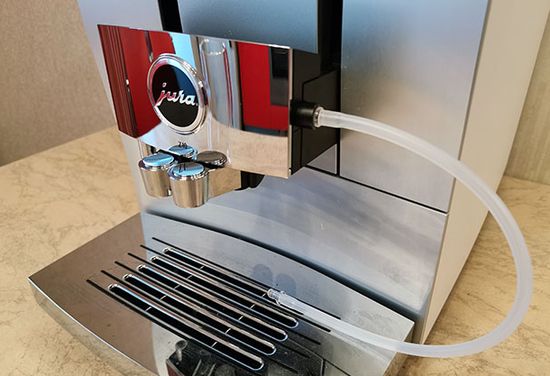
Perhaps the Swiss are thus encouraging consumers to buy branded jugs and milk coolers with a permanent fixation of the milk pipe.
Conclusions
Pros
– 3D brewing technology for ice-free Cold Brew;
– setting the temperature of milk and milk foam;
– innovative Product Recognizing Grinder (P.R.G.) with electronic control;
– comfortable J.O.E. app without registration;
– stylish design;
– traditionally excellent Swiss quality;
– a large number of recipes;
– illumination of cups and water tank.
Cons
– high price (£ 2,145.00 or almost $ 3,000);
– milk hose is not fixed;
– no automatic rinsing the milk hose;
– inconvenient left / right swipes due to the large number of big shortcuts on the screen;
– no user profiles.
Milk and milk foam temperature setting, 3D brewing technology and Product Recognizing Grinder make the Jura Z10 the most innovative coffee machine on the market. Of course, the price tag of around $ 3,000 is high. But excellent Swiss quality and substantial innovation are up to this level.
In fact, its price is commensurate with the cost of more expensive built-in coffee machines. For comparison, the prices of built-in SMEG coffee machines range from $ 2,250 to $ 3,360, while premium built-in Miele SVA 7xxx series costs $ 4,000 and up. On the other hand, this factor is not very important in a spacious kitchen. Moreover, the mobility of desktop models is a significant advantage compared to built-in coffee machines.
In principle, the Z10 can be positioned as a premium version of the excellent Jura S8 or Jura E8, and even the budget Jura E6 EB. These models are cheaper and make great coffee, but do not have the latest Jura’s innovations.
This video demonstrates the Z10’s capabilities when used optimally.
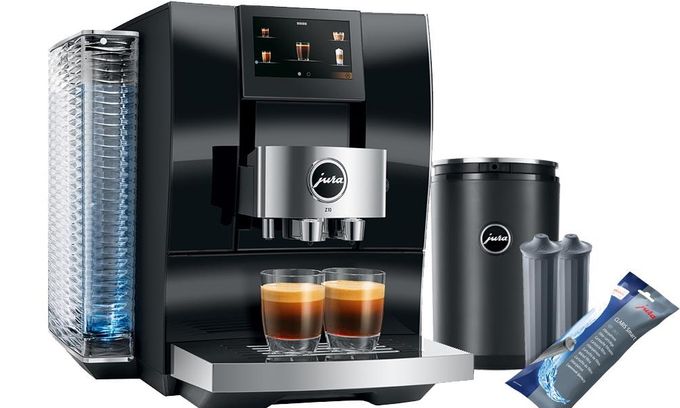
Pingback: New EB version of Jura E6 coffee machine. Review - The Appliances Reviews
Pingback: Evolution of Jura Impressa S8 vs E8 automatic espresso coffee machines Review - The Appliances Reviews
Pingback: Newest Jura E8 EB coffee machine Review - The Appliances Reviews